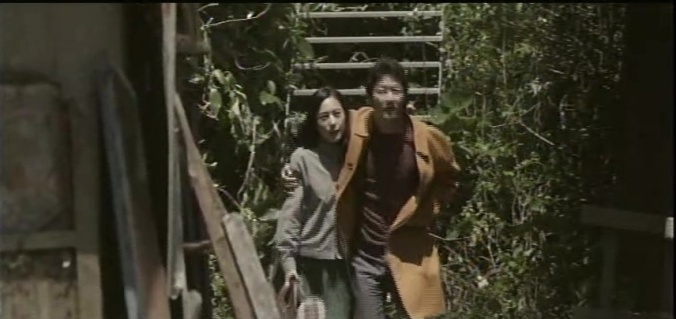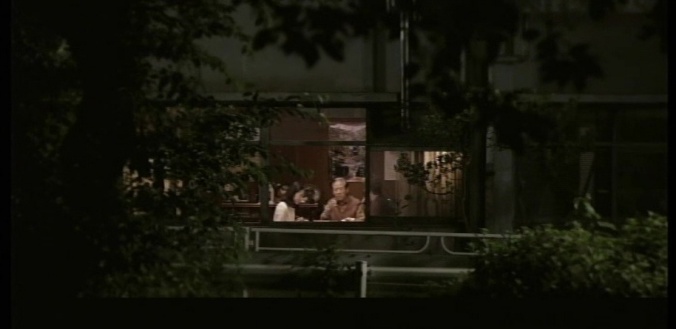
The husband’s ghost returns for dinner
If your dead husband suddenly reappears after three years, what do you do? If you’re Japanese, the first thing you say is “Take off your shoes.” Or so we are told in Kiyoshi Kurosawa’s Journey to the Shore, a contemporary take on the ghost story that, if nothing else, demonstrates that the Japanese still do things differently.
The basic shape of the movie is familiar. The dead husband’s ghost reappears and gradually helps the wife deal with her grief until at last he can disappear forever. But we’re a long way from Ghost.
Mizuki has been living in a walking stupor since her husband Yusuke drowned, apparently a suicide, giving the occasional piano lesson but little more. One night, her husband suddenly reappears as she is cooking dinner. For a while we are not sure if he is a ghost or a figment of her imagination, but eventually we realize that other people can see him too, so he also seems to be real. Nevertheless, he insists that he is dead and offers to take her on a trip to visit the people who “helped” him in the three years since his death.
There does not seem to be a pattern to or moral to be drawn from the three visits they make. One is to an old man who is dead, like Yusuke, but does not know it. Another is to a restaurant where he made gyoza and where everyone is alive and normal, though the wife has regrets about her treatment of her younger sister long years ago. The final visit is to a family in a tiny village where, again, everyone seems to be alive until at last we discover that Kaoru has also lost her husband and that Yusuke brought her home when he ran into her making a similar set of visits with her dead husband, who was reaching the end of his time. Kaoru’s grief is so strong that her husband materializes against his will, but he is so weak he can not even stand and eventually just disappears completely. At that point, it becomes clear that Yusuke himself is also beginning to lose his strength, and he and Mizuki only make it to the shore of a quiet bay, where he too disappears and she burns the hundred prayers for his safe return she has carried with her since he left.

Yusuke’s last moments
This is not a dream, for when she returns to her apartment, the plants have died and the mail is piled up on the floor. Yet, unlike an American approach, we are not told that the ghost will always watch over Mizuki, nor do we have any great reconciliation or apology scene that at last frees everyone. We simply work through a process, without quite knowing what the process is.
In the grand Japanese film tradition, it is a quiet movie that takes its time, over two hours. Never “dramatic,” it is also never boring. But at the end, though Mizuki burns the prayers and sits alone, we do not see a magic cure. She may be at peace at last, but we do not see what happens next. Presumably she is now ready to get on with her life, but we do not see her do so.
There are some scenes so odd that we know they must be meaningful, but we’re not quite sure what the meaning is. In the tiny village, for example, Yusuke is famous for his talks on physics (!!!), and one particular talk about how light can have no mass and yet clearly exist seems to have some thematic meaning to his situation. But what that might be is left up to the viewer.
Eri Fukatsu as Mizuki is about as woe-be-gone as it is possible to be; only in the last few scenes in the countryside, where she forsakes her mid-calf skirt and droopy hair for peasant women’s pants and a ponytail does she begin to even suggest she can stand up straight. As Yusuke, Tadanabu Asano is all but expressionless, which maintains the tone of realistic appearance but does reduce dramatic impact.
Kurosawa made his international fame with earlier horror films like Pulse and Cure, so a revisit to the ghost world is not a surprise. But even in the more traditional horror films, he was more concerned with mood than with shock, and he has always been willing to take his time telling the story, to the point of seeming leaden to many American viewers. This is done here with a minimum of effects from the lab — some fog that moves in odd ways and some individual characters who go dark in otherwise normal lighting. Otherwise, it is traditional movie-making. Its pacing and its “what-you-see-is-what you get” attitude seem to me at least to mark this as a movie that could only have been made by a Japanese film-maker. Perhaps Tarkovsky might have made something like this from the story, but he was sui generis, not part of a Russian film tradition.

dinner with the dead man, a typical scene in long shot
Kurosawa is part of a Japanese tradition. Though he does not use the sideways dolly shots of Mizoguchi, everything else — the pacing, the persistent use of medium and long shots (some so long that we are not sure who is actually talking at any given moment), and the sense that the audience already knows so there is no need to explain things — all can be traced back as a regular part of Japanese film-making at least to Mizoguchi’s films.
Pingback: War of the 16 Year Olds / Juroku-sai no senso (1973-76)* | Japanonfilm
Pingback: Tokyo Sonata (2008) | Japanonfilm